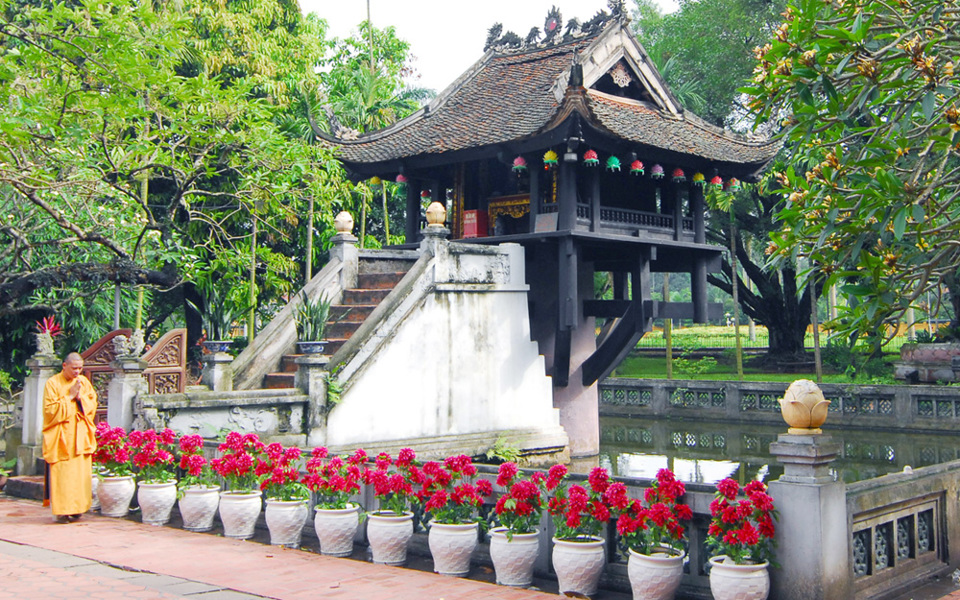Hanoi determined to make cultural institutions effective
It is possible to concretely realize the goal of fostering culture in the city’s development through the appropriate use of cultural institutions.
Making effective use of cultural institutions in Hanoi is a way to concretize the mission of developing a culture in the city’s long-term development.
| Chua Mot Cot (One-pillar pagoda), one of the typical cultural institutions in Hanoi. Photo: The Hanoi Times |
It becomes necessary as culture is defined as one of the three pillars of the city’s Party missions for 2020-2025.
It states, “Make Hanoi’s culture and people truly a great spiritual value, an important endogenous resource that determines the sustainable development of the capital.”
Additionally, culture is mentioned in the Hanoi Party Committee’s Program No.06 on “Developing Culture, Improving the Quality of Human Resources, Building Elegant, and Civilized Hanoians in the Period of 2021-2025” and the committee’s Resolution No.09 on “Developing the Cultural Industry in the Capital Area for the Period of 2021-2025, Orientation to 2030, Vision to 2045.’
In this regard, the city has put forward strategies and plans to increase the effectiveness of financing, utilization, management, and use of cultural and sports institutions to support cultural and spiritual pursuits. As a result, it contributes to raising people’s quality of life following the municipal Party Committee’s Resolutions and Programs, said Chairman of the Hanoi People’s Council Nguyen Ngoc Tuan.
Meanwhile, the Hanoi People’s Committee continues building planning on grassroots cultural institutions. At the same time, it has made policies on managing cultural facilities.
Accordingly, the city has mobilized financial resources from the state budget and different stakeholders to the planning, investment, and management of the cultural institutions citywide.
In order to achieve these goals, the city has supported managerial works at the grassroots level with the participation of craftsmen and artisans in public programs which meet the needs of residents.
In talks with The Hanoi Times, Vice Chairman of the Vietnam Association of Historical Sciences Nguyen Quang Ngoc said the city has emphasized a comprehensive approach to cultural development and cultivating the city's citizens.
The implementation promotes Hanoi's culture and people as one of the three breakthroughs during the Party committee's five-year term starting in 2021. The program views culture as a force for advancement and places it on an equal footing with economics, politics, and society.
Assets
According to Hanoi’s statistics, as of the first quarter of 2023, the city is home to 383 cultural and sports institutions under the management of different agencies; 84 cultural and sports institutions in all 30 districts and towns; and cultural houses in 85% of community facilities.
The city’s increased investment in cultural institutions is reflected in establishing museums, libraries, monuments, and cinemas. On the list, dozens of typical ones are a 55-hectare Hanoi Sports Training Center in Nam Tu Liem District that hosts SEA Games, Indoor Games, and other international sports events.
Currently, the city is conducting new projects on the Children’s Cultural House, the Opera House in West Lake, Cultural Spaces, and Walking Streets in the districts of Hoan Kiem, Ba Dinh, Hai Ba Trung, Dong Da, Hoang Mai, and Tay Ho, and Son Tay Town.
Notably, the city decided in the Red River urban subdivision planning project to plan a system of cultural centers along the Red River's south and north banks to suit the area's institutional, cultural, and sporting demands.
As for other spatial axes, the city is still reviewing and updating Hanoi Capital Construction’s general planning, calculating the land fund for cultural centers, open spaces, and cultural activities.
On the other hand, cultural institutions serve as tourist attractions to draw visitors. Indeed, Hanoi’s historical and cultural heritage is amazing in its uniqueness and adaptability.
Hoan Kiem Lake is the starting point of almost all tour programs and the center of the city’s historic district. It is surrounded by an extraordinarily wonderful park. This area is ideal for hiking. It is not far from the picturesque Old Quarter. Another place of interest in the heart of the central part is a man-made island in the serene lake and Ngoc Son Temple located near the northern shore of the lake.
The one-pillar pagoda Chua Mot Cot is one of the oldest and most fascinating attractions in Hanoi. It was reportedly constructed in the sixth century and underwent its last significant repair around 1815.
Ho Tay or West Lake is the largest lake in the city. It's undoubtedly worth mentioning when discussing remarkable natural features. There are a number of remarkable temples, palaces, and top-notch hotels on its shores. This location is especially well-liked by tourists as a result.












